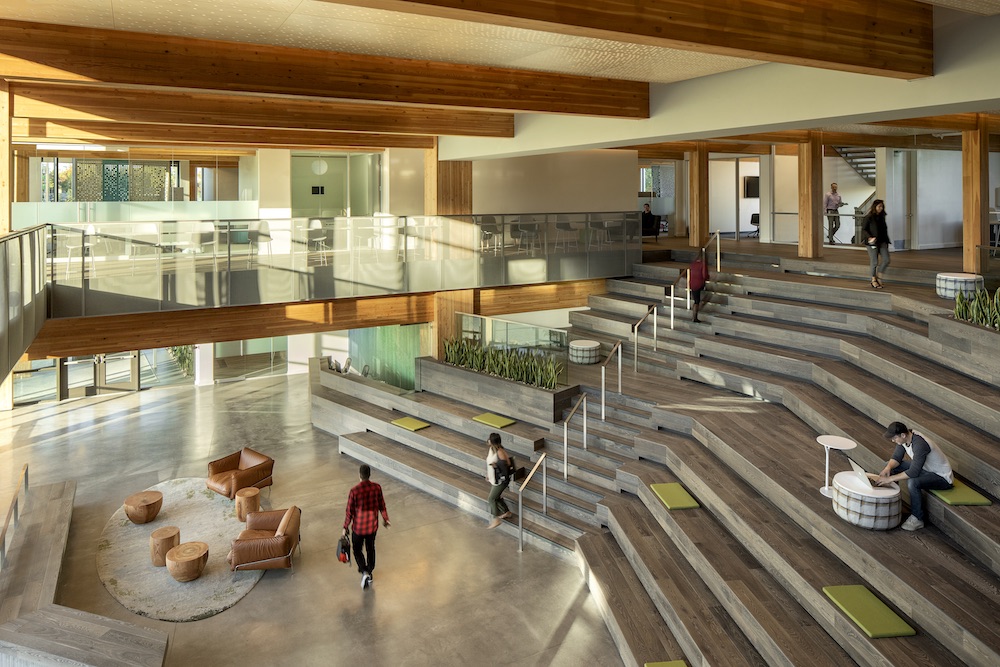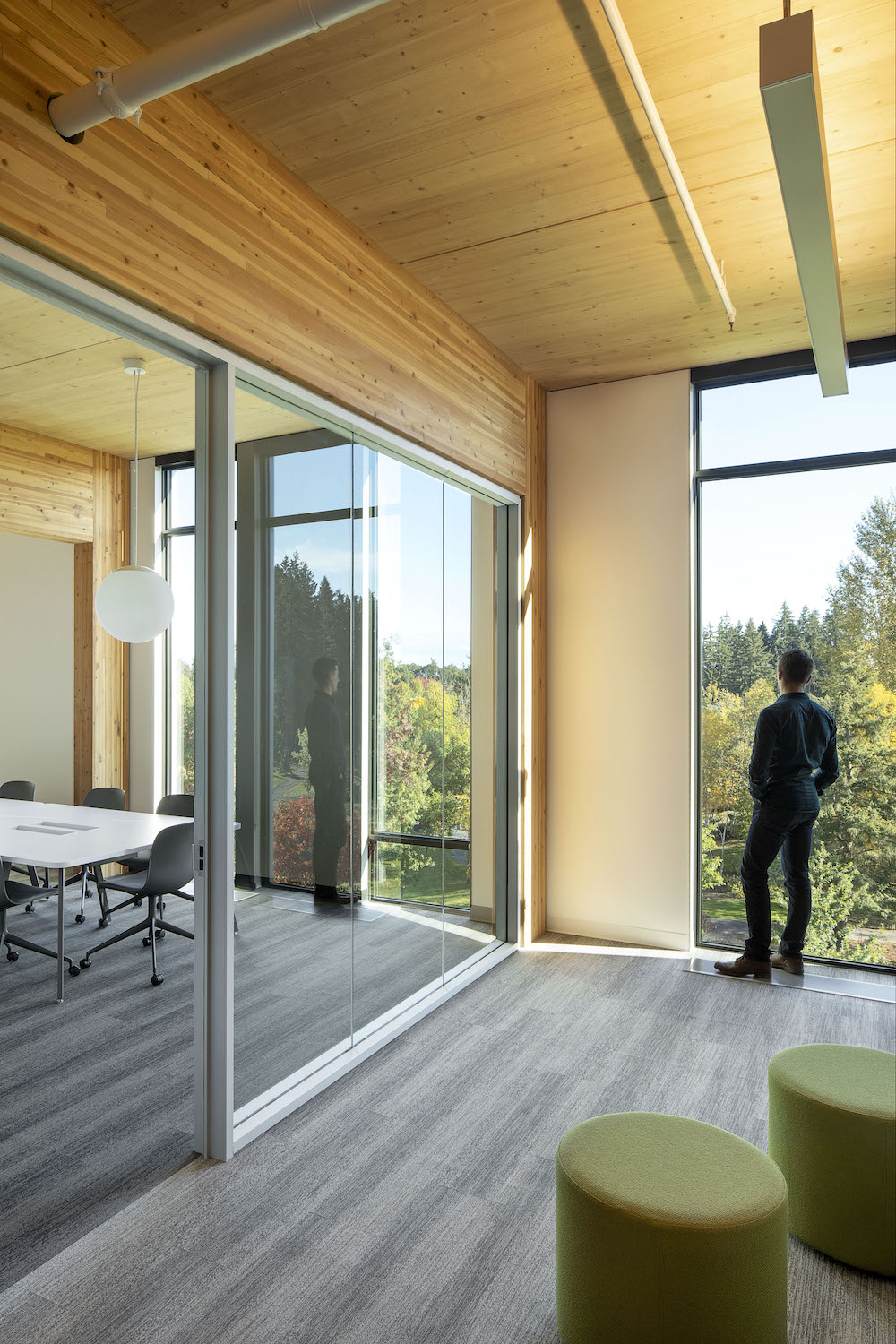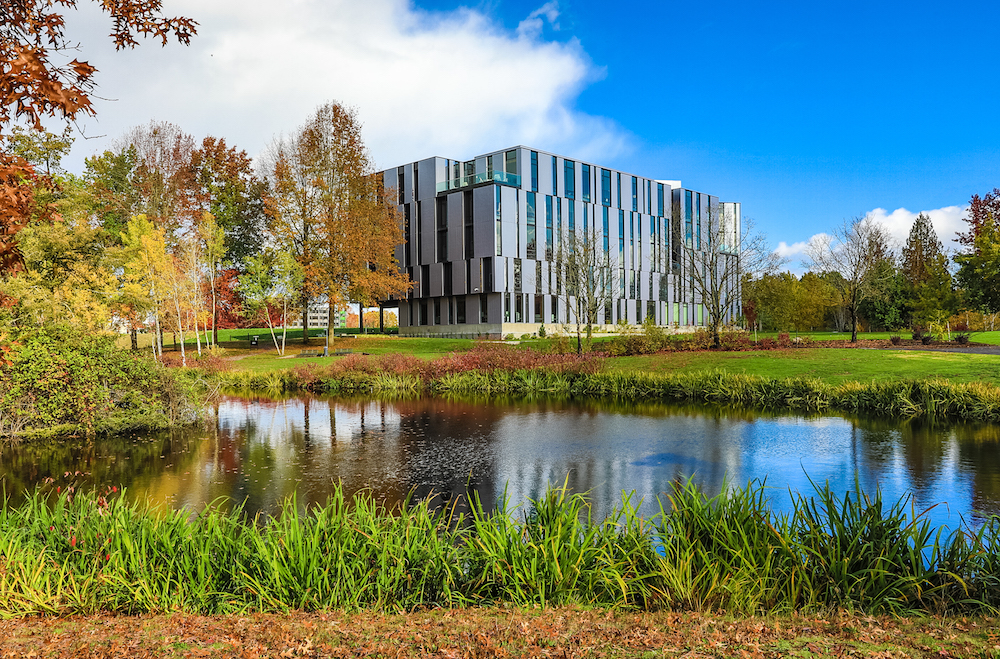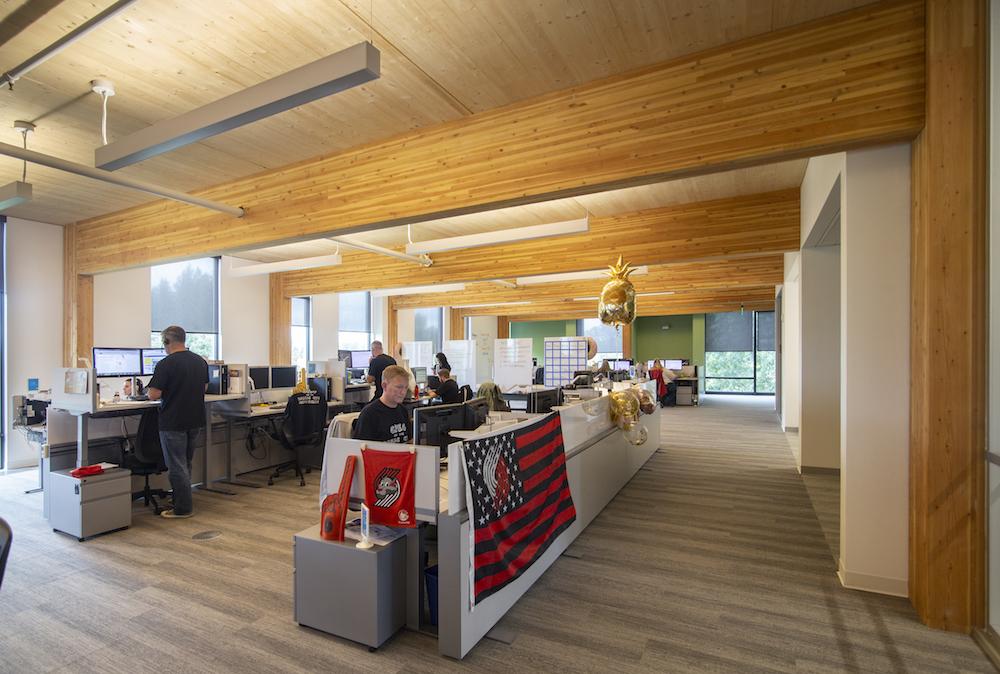Swinerton’s Erica Spiritos explores the health and wellness benefits of using mass timber in workplace design.

Employers are reaping the benefits of investing in creative environmental adaptations that contribute to improved employee health and mental well-being, as well as overall workplace satisfaction – including biophilic design elements. And while companies are not expected to make significant structural transformations in the wake of COVID, investments in warm, relaxing environments have proven to ease stress and contribute to happier, healthier work environments as workers return to the office.
Health and Wellness Benefits of Mass Timber in the Workplace
First Tech Federal Credit Union’s new 156,000- square foot headquarters situated on a 17-acre parcel of serene parkland in Hillsboro, Ore., features a mass timber structure that blends wood with modern architectural touches such as floor-to-ceiling windows, canned lighting and ergonomic office furniture. Priority was also placed on connecting the approximately 900 employees to the building and the outdoors. The design-build team chosen to develop the space and used mass timber to bring a natural aesthetic indoors, thus creating a warm, inviting and comfortable workplace.
First Tech is in good company. According to Woodworks, as of Sept. 2020 there were 979 mass timber projects constructed or in design in all 50 states in the multifamily, commercial or institutional categories. The tangible and intangible benefits of mass timber are differentiating these buildings from the rest in a competitive market where clients prefer partners who share their values of sustainability, employers are seeking to attract and retain top talent, and employees are striving for balance, productivity and success.

Another of the country’s top tech employers, Google is embracing wood as an essential element to creating innovative, desirable workplaces with its high-profile adaptive reuse construction, the “Spruce Goose,” located in Playa Vista near Los Angeles International Airport. The large, timber-framed hangar – constructed in 1943 by businessman, film producer and pilot Howard Hughes – was overhauled to serve as a 450,000-square foot facility for Google, complete with offices, conference rooms, cafes, a fitness center and a 250-person event space.
The physiological influencers that accompany a more natural work environment also benefit the bottom line and financial health of organizations. Happier workforces tend to log fewer sick days and remain loyal to the organization, resulting in less turnover.
The unique physiological impact of touching wood has been shown to reduce sympathetic nervous activity and blood pressure – a phenomenon not experienced with any other building material. A 2018 study by Forest and Wood Products Australia, “Workplaces: Wellness + Wood = Productivity,” found that wood is correlated with higher levels of concentration, improved mood and personal productivity, while a study by the University of British Columbia, “Wood in the Human Environment: Restorative Properties of Wood in the Built Indoor Environment, concluded that “wood provides stress-reducing effects similar to the well-studied effect of exposure to nature in the field of environmental psychology. The practical implication of this effect is that wood may be able to be applied indoors to provide stress reduction as a part of the evidence-based and biophilic designs of hospitals, offices, schools and apartment buildings.” Replacing concrete and steel with natural materials with biophilic quality connects employees to nature reminding them of their place within the ecosystem and environment.

Beyond the health benefits and intrinsic perks of a cool space, mass timber construction can minimize the construction timeline as much as 25 percent, while also reducing the budget and increasing quality of work by leveraging prefabricated materials processes. Facilities are also able to reduce carbon dioxide emissions by up to 20 percent due to the sustainability of the wood construct on energy, the utilization of light and the lack or minimization of steel.
Several myths and misperceptions persist regarding the use of wood in our built environment. For one, it has been the common misperception that wood is less sanitary than other materials due to the porosity and organic composition of wood. With the renewed interest in designing with this material in all market sectors (including healthcare), The University of Oregon currently is conducting research to explore the microbiome of wood relative to other surface materials used in the built environment. While the existing body of research on this topic is not extensive, studies have shown wood to be a naturally antimicrobial material. Research is also showing that bacteria appear to be less readily transferred from wood than from plastic. Many questions remain to be answered, but the industry is excited about the prospect of wood as a health-promoting surface.
Another concern of mass timber as it pertains to human health is with the adhesives, as indoor air quality is an important factor for tenants. A common misperception surrounds the potential toxicity of the glues used in mass timber construction. Adhesives comprise just one percent of the overall material volume and most of those used are low VOC, nontoxic and formaldehyde-free.

Wood has also been shown to contribute to a healthier environment by regulating indoor relative humidity to a human-friendly range. When conditions are dry, wood releases moisture into air. Likewise, when air is saturated, some of the moisture will be absorbed into the timber component, maintaining a healthier environment equilibrium. The equilibrium moisture content of wood actually aligns with healthy humidity levels for humans.
What About Sustainability?
We cannot talk about human health without considering the health of our planet. In this vein, many ask – Is it environmentally friendly to cut down trees for mass timber construction? In the United States, the majority of forest land is privately owned. Without a market for forest products, landowners become financially strapped and are forced to sell to homebuilders or cattle farmers, resulting in the permanent deforestation of timberlands through long-term land-conversion. Building with mass timber supports long-term forestry preservation.
There are many tangible benefits of building with mass timber, particularly in a market where there is little to no precedent. Mass timber buildings not only add tremendous value to the urban landscape by reducing our footprint, but also simultaneously contribute to occupant health and wellness.

